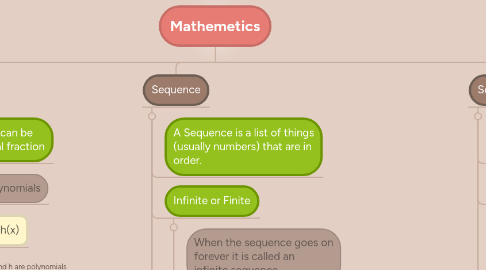
1. Vector
1.1. object that has both a magnitude and a direction.
1.1.1. Picture that a vector as a directed line segment, whose length is the magnitude of the vector and with an arrow indicating the direction.
2. Trigonometry
2.1. the studies of the relationships involving lengths and angles of triangles.
2.2. 3 things you should remember
2.2.1. Adjacent is adjacent (next to) to the angle θ
2.2.2. Opposite is opposite the angle θ
2.2.3. the longest side is the Hypotenuse
2.3. Sine, Cosine and Tangent
2.3.1. Sine funtion:
2.3.1.1. sin(θ) = Opposite / Hypotenuse
2.3.2. Cosine function:
2.3.2.1. cos(θ) = Adjacent / Hypotenuse
2.3.3. Tangen function:
2.3.3.1. tan(θ) = Opposite / Adjacent
3. Rational fuction
3.1. any function which can be defined by a rational fraction
3.1.1. quotient of polynomials
3.1.1.1. y = g(x) / h(x)
3.1.1.1.1. where g and h are polynomials (h not equal 0).
3.2. A rational function will have an x-intercept -- y will equal 0 -- only if the numerator g(x) = 0.
3.3. Singularity
3.3.1. any value of the variable that would make a denominator 0.
3.4. The reciprocal function
3.4.1. a function defined on the set of nonzero reals, that sends every real number to its reciprocal
3.4.2. f(x) = 1/x
3.4.3. Domain is the Real Numbers, except 0, because 1/0 is undefined.
3.4.3.1. Using set-builder notation:
3.4.3.1.1. Its Domain is {x member of Reals | x ≠ 0}
3.4.3.1.2. Its Range is also {x member of Reals | x ≠ 0}
4. Sequence
4.1. A Sequence is a list of things (usually numbers) that are in order.
4.2. Infinite or Finite
4.2.1. When the sequence goes on forever it is called an infinite sequence,
4.2.2. otherwise it is a finite sequence
4.3. In Order
4.3.1. When we say the terms are "in order", we are free to define what order that is! They could go forwards, backwards ... or they could alternate ... or any type of order we want!
4.4. Like a Set
4.4.1. A Sequence is like a Set, except:
4.4.1.1. the terms are in order (with Sets the order does not matter)
4.4.1.2. the same value can appear many times (only once in Sets)
4.5. Arithmetic Sequences
4.5.1. the difference between one term and the next is a constant.
4.6. Geometric Sequences
4.6.1. multiplying the previous term by a constant.
5. Series
5.1. the sum of the terms of a sequence.
5.2. Finite sequences and series
5.2.1. first and last terms
5.3. Infinite sequences and series
5.3.1. continue indefinitely
5.4. Geometric series
5.4.1. where each successive term is produced by multiplying the previous term by a constant number
6. Basic counting
6.1. The Basic or Fundamental Counting Principle can be used determine the possible outcomes when there are two or more characteristics can vary.
6.1.1. To determine the total number of outcomes, multiply the number of possibilities of the first characteristic times the number of possibilities of the second characteristic.
6.2. Dependent or Independent
6.2.1. Dependent
6.2.1.1. A variable that depends on one or more other variables.
6.2.1.1.1. For equations such as y = 3x – 2, the dependent variable is y. The value of y depends on the value chosen for x. Usually the dependent variable is isolated on one side of an equation.
6.2.2. Independent
6.2.2.1. A variable in an equation that may have its value freely chosen without considering values of any other variable.
6.2.2.1.1. For equations such as y = 3x – 2, the independent variable is x. The variable y is not independent since it depends on the number chosen for x.
7. Probability
7.1. the measure of the likeliness that an event will occur.
7.2. Probability Of An Event
7.2.1. P(A) = The Number Of Ways Event A Can Occur / The total number Of Possible Outcomes
7.3. Tossing a Coin
7.3.1. When a coin is tossed, there are two possible outcomes:
7.3.1.1. heads (H)
7.3.1.1.1. the probability of the coin landing H is ½.
7.3.1.2. tails (T)
7.3.1.2.1. the probability of the coin landing T is ½.
7.4. Throwing Dice
7.4.1. When a single die is thrown, there are six possible outcomes: 1, 2, 3, 4, 5, 6.
7.4.1.1. The probability of any one of them is 1/6.
